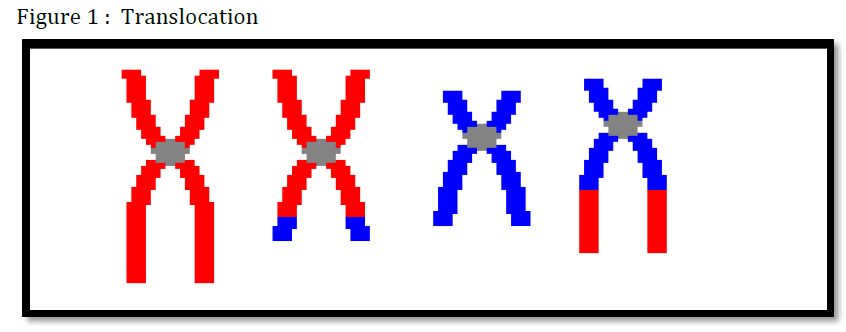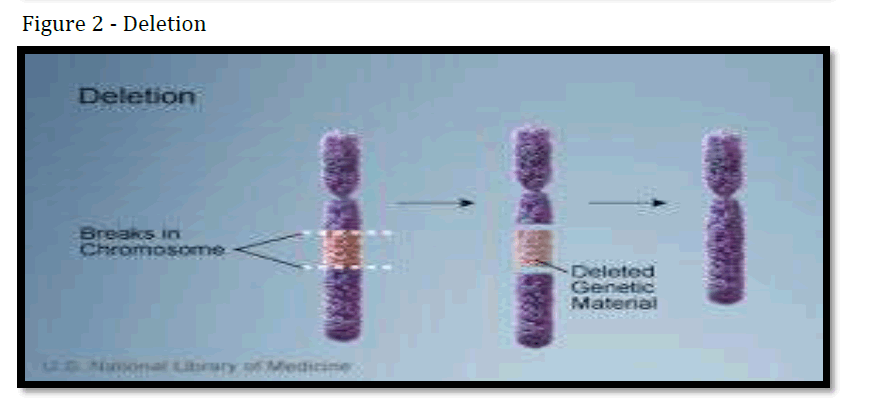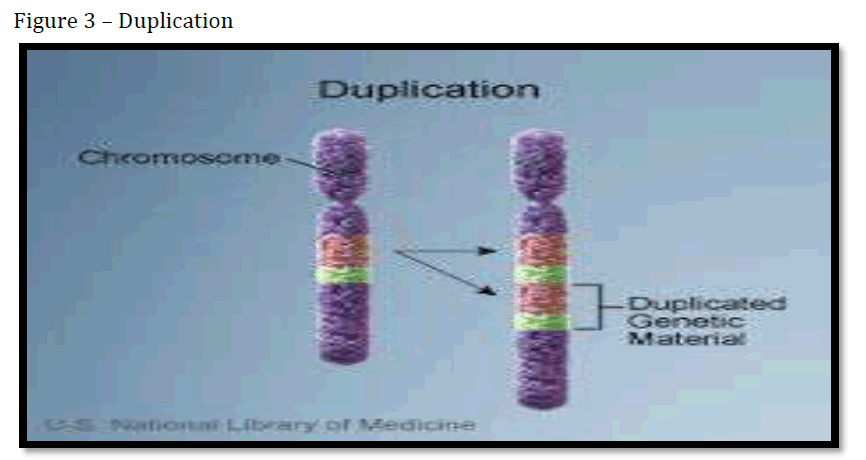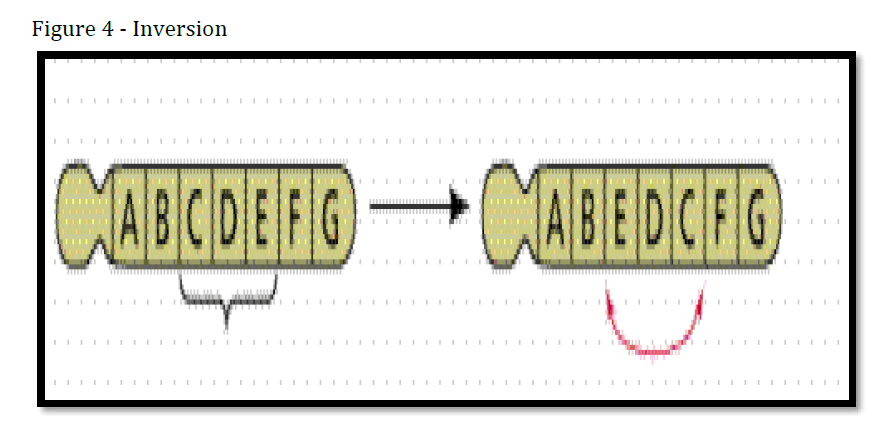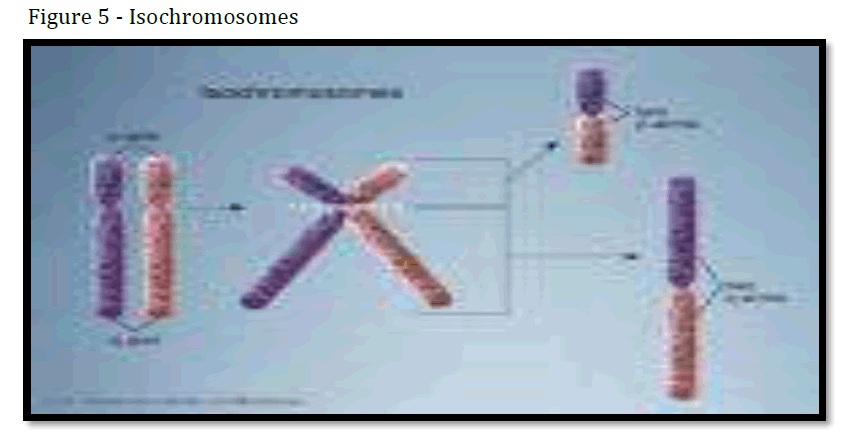Review Article- Asian Journal of Pharmaceutical Technology and Innovation(2018)
Genetic Disorders : Health and Oral Health – A Review
Suvarna V Biradar*Dr. Suvarna V Biradar, Senior Lecturer, Department of Public Health Dentistry, HKDET’S Dental College Hospital & Research Institute, Humnabad 585330. Bidar, Karnataka, India, Tel: +918970831926, Email: suvarna13gulbarga@gmail.com
Received: 10-Jan-2018 Accepted Date: Jan 18, 2018 ; Published: 20-Jan-2018
Abstract
The basic principles of genetics were laid down by GREGOR MENDEL AND FRANCIS GALTON towards the close of 19th century. But, it is only during the past few years the science of genetics and human genetics has made rapid progress. The discovery of biologic role of nucleic acids, the uncovering of the structure of the genetic information and its role in regulating life processes are discoveries, the importance of which can hardly be overestimated. Human genetics is much more than the study of mere hereditary diseases. It has emerged as a basic biological science for understanding the endogenous factors in health and disease. Owing to the rapid specialization, several branches in genetics have come into being examples – Cytogenetics, Clinical genetics, Biochemical genetics, Pharmacogenetics, Immunogenetics, Population genetics and so on. Achievements in these fields have created a basis for effective medical and preventive intervention in many diseases and also possibly of “Genetic Engineering” that is of controlling the traits of an individual.
Keywords
Genetics, Inherited disorders, Down’s syndromeIntroduction
The basic principles of genetics were laid down by GREGOR MENDEL AND FRANCIS GALTON towards the close of 19th century. But, it is only during the past few years the science of genetics and human genetics has made rapid progress.The discovery of biologic role of nucleic acids, the uncovering of the structure of the genetic information and its role in regulating life processes are discoveries, the importance of which can hardly be overestimated.
With increasing control of communicable diseases and infant mortality, inherited abnormalities are assuming a proportionately greater importance in medical practice. Over 2,300 hereditary diseases have been identified and more are added to the list every year. According to many authors, genetically conditioned diseases or diseases with a clear genetic component account for 20-40 percent of all cases treated by the health services.
Human genetics is much more than the study of mere hereditary diseases. It has emerged as a basic biological science for understanding the endogenous factors in health and disease. Owing to the rapid specialization, several branches in genetics have come into being examples – Cytogenetics, Clinical genetics, Biochemical genetics, Pharmacogenetics, Immunogenetics, Population genetics and so on. Achievements in these fields have created a basis for effective medical and preventive intervention in many diseases and also possibly of “Genetic Engineering” that is of controlling the traits of an individual.
CHROMOSOMES
Chromosomes are rod-like condensation of chromatin. They become visible in the nucleus only during cell division They occur in pairs – one member of each pair comes from the father and other from the mother. Biochemically they are made up of DEOXYRIBONUCLEIC ACID (DNA).Genetically they consists of GENES.
GENES
Genes are the units of heredity.They contain the hereditary information encoded in their chemical structure for transmission from generation to generation. Genes also appear in pairs. If the genes comprising a pair are alike (AA), the individual is described as HOMOZYGOUS for that gene and if it is different (Aa) the individual is described as HETEROZYGOUS. A gene is said to be dominant when it manifests its effect both in the heterozygous and homozygous state.A gene is said to be recessive when it manifests its effect only in the homozygous state. Mutation is a sudden change in genes – UV rays or chemical carcinogens
Genetics
Genetics is the study of heredity, and variation in living organisms
(Source : Griffiths, JF Anthony. Genetics and the Organism: Introduction. An Introduction to Genetic Analysis 7th ed. New york; 2000)
Genomics
Is the study of genes and their functions and related techniques (Source : WWW.WHO.Int/genomics/geneticsvsgenomic/en/)
Basic information related to Genetics
A. Cytologic facts
✓ In 1956, Tjio and Levan surprised the scientific world by reporting that they could find only 46 chromosomes in the normal human karyotype. This was immediately confirmed by other workers.
✓ The normal human body cell contains 46 chromosomes that is 22 pairs of autosomes and a pair of sex chromosomes, XX in the females and XY in the males.
✓ The chromosomes vary in length, the longest being about five times as long as the smallest
✓ The autosomes are numbered according to their length, the first pair being the longest and the last pair the shortest
✓ The sex chromosomes are not included in the numbering, but are merely termed as X and Y.
✓ The autosomes have been classified and divided on the basis of length and certain morphological similarities into 7 groups.They are as follows :
Group A 1 to 3 pairs
Group B 4 and 5 pairs
Group C 6 to 12 pairs X CHROMOSOME
Group D 13 to 15 pairs
Group E 16 to 18 pairs
Group F 19 and 20 pairs
Group G 21 and 22 pairs Y CHROMOSOME
Cell Division
There are two types of cell division.They are Mitosis and Meiosis.
Mitosis
During cell division, each chromosome divides lengthwise into two sister chromosomes called CHROMATIDS. The chromatids are joined together at a point called CENTROMERE. Then, the chromatids separates, one goes to one daughter cell and one to the other daughter cell. In this way, each daughter cell inherits same number and same kind of sister chromosomes. This process of nuclear division is called “MITOSIS”.
Meiosis
The reproductive cells (sperms and ova) are produced in a different manner.There are two nuclear divisions and only one chromosome division. This form of division is called “Reduction division” or “Meiosis”.The full compliment of 46 chromosomes is called the diploid number and the half set of 23 is called the haploid number.
▣ Genotype refers to the total genetic constitution of an individual
▣ Phenotype refers to the outward expression of the genetic constitution
▣ Example : ABO Blood group system
✓ The possible genotypes are : AA, AB, BB, AO, BO and OO
✓ The phenotypes are : A, B and O.
B. Laws of Inheritance
Mendel formulated certain laws to explain the inheritance of characters
I. Law of unit characters
II. Law of dominance
Law of segregation
I. Law of unit characters
All characters are units by themselves and certain factors (now called genes) control the expression of these characters during the development of the organism
II. Law of dominance
The factors or genes occur in pairs. The character that expresses itself in F1 generation is said to be dominant and the character that does not appear in the F1 generation is said to be recessive
III. Law of segregation
When germ cells are formed, Mendel supposed, that the factors are separated or segregated so that each germ cell carries one or other of the two factors and not both.
III. Classification of genetic disorders
A. Chromosomal Abnormalities
B. Unifactorial (Single gene or Mendelian) diseases
C. Multifactorial diseases
A. CHROMOSOMAL ABNORMALITIES
I. Relating to sex chromosomes
1. Klinefelter’s syndrome
2. XYY syndrome
3. Turner’s syndrome
4. Super females
II. Relating to autosomes
1. Down’s syndrome or Mongolism or Trisomy 21
(Source: Park K. Textbook of Preventive and Social Medicine 21st edition.Jabalpur,India:M/s Banarsidas Bhanot; pg.760-770)
A. CHROMOSOMAL ABNORMALITIES
1. Klinefelter’s syndrome
This is a common sex chromosome aneuploidy. Persons suffering from this syndrome are abnormal males having two or more X chromosomes in addition to one Y chromosome (XXY, XXXY).This condition is associated with mental retardation.The incidence of this syndrome is about 1 in 1000 males at birth.
2. XYY Syndrome
The male with an extra Y chromosome has attracted much attention because of his reported tendency to antisocial, aggressive often criminal behaviour. However, the relationship is not clear Features : Exceptional height (usually six feet and over) and serious personality disorder leading to behavioural disturbances
❏ The incidence of this syndrome is about 1 in 1000 males at birth
3. Turner’s Syndrome
Persons suffering from this syndrome are apparent females with underdeveloped sex glands.They have 45 chromosomes instead of the normal complement of 46.Their sex chromosome constitution is XO instead of XX (O represents the missing chromosome).This abnormal condition is due to non-disjunction of the sex chromosomes. Clinically the patients are of short stature, infertile and have primary amenorrhoea. Congenital defects include coarctation of the aorta,pulmonary stenosis and renal malformations and mental retardation.
4. Super females
Females with 3 to 5 X chromosomes (XXX, XXXX, XXXXX). The higher the number of X chromosomes, the greater the degree of mental retardation and congenital abnormalities.
2. Relating to autosomes
1. Down’s syndrome or Mongolism or Trisomy 21
Described by LANGDON DOWN in 1866.Caused by an extra chromosome which occurs on the 21st pair. Features – Child and adult by short stature, small round head, tilted eye slits, mal-formed ears, short broad hands and mental retardation.
Dental problems : Hypoplastic maxilla, macroglossia, Scrotal or fissured tongue, Class III tendency, anterior and posterior cross bites, Acute necrotising ulcerative gingivitis.
B. Unifactorial (Single gene or Mendelian) diseases
They are inherited according to Mendelian laws. These are : The Dominant, Recessive and Sex linked disorders.
1. Erythroblastosis foetalis
If the foetus is Rh positive and the mother Rh negative, certain consequences are likely to occur.
Some of the foetal red blood cells cross the placenta and enter the maternal circulation where they act as foreign antigen and the production of Rh antibodies. Rh antibodies will cross the placental barrier and enter into the blood circulation of foetus. When this happens the RBCs of foetus are destroyed. If the damage is severe, the foetus is killed in utero and results in miscarriage If the damage is less severe, the infant may be born with jaundice, anaemia and oedema. This symptom complex is known as Rh Haemolytic disease or Erythroblastosis Foetalis.
2. Sickle cell anaemia
Is an autosomal recessive disorder in which an abnormal haemoglobin leads to chronic haemolytic anaemia with a variety of severe consequences.
Classic example : Point mutation in DNA. Individuals with one gene of this disease are clinically healthy, but their RBCs look abnormal under the microscope. Persons with 2 genes (homozygous) of this disease suffer from acute anaemia and in most cases die before puberty.The rate of sickling is influenced by the concentration of haemoglobin S in the individual red blood cell. The disorder has its onset during the first year of life , when haemoglobin F level falls.These patients are prone to delayed puberty. On examination, patients are often chronically ill and jaundiced, hepatomegaly but the spleen is not palpable in adult life, the heart is enlarged, with hyperdynamic precardium and systolic murmurs. No specific treatment is available.Prenatal diagnosis is now available for couples at risk of producing a child with sickle cell anaemia.
3. Thalassemias
Are hereditary disorders characterized by reduction in the synthesis of globin chain (alpha or beta). Alpha thalassemia is due to gene deletion directly causing reduced alpha globin chain synthesis.Beta thalassemia are usually caused by point mutation rather than large deletions. Signs of thalassemia develop after 6 months of age, because this is the time when haemoglobin synthesis switches from haemoglobin F to haemoglobin A. Prenatal diagnosis is now available for couples at risk of producing a child with one of the severe thalassemia syndromes.
4. Haemophilia
Is a hereditary bleeding disorder. There are different forms of haemophilia. The disorder concerns the absence, decrease or deficient function of blood clotting factor, leading to excessive, prolonged or delayed bleeding.
5. Cystic fibrosis
Is a genetic disease occuring worldwide, which affects the respiratory and gastrointestinal tracts and the sweat glands. The gene defect in cystic fibrosis was identified in 1989, since then there has been unprecedented progress in understanding the disease, leading to new approaches to drug treatment and hopes for gene therapy.
6. Phenylketouria (PKU)
Is an autosomal recessive disorder resulting in a deficiency of the liver enzyme Phenylalanine hydroxylase which converts phenylalanine to tyrosine.Frequency of disease is about 1 in 10,000 births. Phenylalanine accumulates in the blood and tissues and has a toxic effect on the brain leading to mental retardation.
C. Multifactorial diseases
They are caused due to influence of multiple genes and environmental factors. These include mainly the non communicable diseases - Diabetes Mellitus, Hypertension, Cardiovascular diseases and Cancers.
Chromosomal Abnormalities
Chromosomal abnormalities (numerical or structural alterations) occur from time to time in human beings.They arise in various ways.
1. Non-disjunction
By an error in nuclear division called ‘non-disjunction’ a pair of chromosomes may fail to separate and both are carries to one pole. The resulting daughter cells contain an unequal number of chromosomes, 45 or 47.This numerical abnormality in which the chromosome number is not an exact multiple of the haploid number is called aneuploidy.If a particular pair of chromosomes has three chromosomes instead of two, it is called trisomy, if there is only one chromosome instead of two in any given pair of chromosomes, it is called monosomy.Non-disjunction may occur during gametogeneis or during mitosis.
2. Translocation
Sometimes during nuclear division, a portion of one chromosome breaks away and becomes attached to another which is not homologous to the first.This is called translocation.
3. Deletion
A piece of chromosome may become detached and lost from the karyotype resulting in the loss of one or more genes. If loss is severe, it may be incompatible with live birth.
4. Duplication
Some genes may appear twice in the same chromosome.This is called duplication.
5. Inversion
Sometimes a chromosomal segment becomes inverted and then the order of sequence is altered.
6. Isochromosomes
These are a special class of structurally abnormal chromosomes, arising because of misdivision that is transverse division instead of the normal longitudinal division.
Management of Chromosomal Abnormalities
A. Preventive and Social Measures
B. Genetic Counselling
C. Genetic Therapy
D. Genetic Engineering
I. Health Promotional Measures
A. Eugenics
B. Euthenics
C. Other Genetic Preventive Measures
II. Specific protection
III. Early Diagnosis and Treatment
IV. Rehabilitation
A. Preventive and Social Measures
I. Health Promotional Measures
A. Eugenics
Galton proposed the term eugenics for the science which aims to improve the genetic endowment of human population.
1. Positive eugenics
This is more ambitious programme than negative eugenics.It seeks to improve the genetic composition of the population by encouraging the carriers of desirable genotype to assume the burden of parenthood.At present, positive eugenics has little application.
2. Negative eugenics
The aim is to reduce the frequency of hereditary disease and disability in the community to as low as possible. Hitler wanted to improve the German race by killing the weak and defective people. But, nobody in the civilized world would approve of such a measure to improve the human race.
B. Euthenics
Mere improvement of genotype is of no use unless the improved genotype is given access to a suitable environment which will enable the gene to express themselves readily. Example - children with mild mental retardation when placed in an encouraging environment show improvement in their IQ.
C. Other Genetic Preventive Measures
1. Consanguineous marriages
2. Late marriages
1. Consanguineous marriages
When blood relatives marry each other there is an increased risk in the offspring of traits controlled by recessive genes and those determined by polygenes. Examples include Albinism, Alkaptouria and Phenylketouria. An increased risk of premature death is also noted in such offspring.
2. Late marriages
Trisomy 21 is more frequent in children born to elderly mothers, lends support to the view that early marriage of females is better than late marriage from the point of view of preventing mongolism. Its incidence in a mother at age 20 is only 1:3000, by the age of 40 it is 1:40.
II. Specific protection
Protection of individuals and whole community against mutagens such as x-rays and other ionizing radiations.Patients undergoing x-ray examination should be protected against unnecessary exposure to radiation. Prevention of Rh Haemolytic disease of newborn by immunization with anti-D globulin.
III. Early diagnosis and prompt treatment
A. Detection of early carriers
It is now possible to identify the healthy carriers of a number of genetic disorders, especially the inborn errors of metabolism. Examples – The female carriers of muscular dystrophy.An X-linked disorder can be detected by elevated level of serum creatine kinase in 80 percent of carriers
B. Prenatal diagnosis
Amniocentesis in early pregnancy (about 14-16 weeks) has made it possible for prenatal diagnosis of conditions associated with chromosomal anomalies. Examples – Down’s syndrome, Galactosemia, Maple syrup urine disease, Alpha – thalassemia and Neural tube defects
Indications
1. Advanced maternal age
2. Previous child with a chromosomal abnormality
3. Family history of chromosomal abnormality
4. Family history of single gene disorder
5. Family history of neural tube defect
6. Family history of congenital structural abnormalities
7. Abnormalities identified in pregnancy
C. Screening of newborn infants
| SCREENING TEST | DISEASE |
|---|---|
| 1. Biochemical screening | Phenylketouria (PKU) |
| 2. Haemoglobin Electrophoresis | Sickle Cell Disease |
| 3. Neonatal Screening – Immunoreactive Trypsin in Guthre blood spots | Cystic Fibrosis |
Table 1: Screening of newborn infants.
D. Recognizing pre-clinical cases
Examples
1. Heterozygotes for Phenylketouria can be detected by a PHENYL ALANINE TOLERANCE TEST
2. Examination of close relatives of diabetics by a glucose tolerance test will often reveal preclinical cases of ACHOLURIC JAUNDICE
3. A raised serum uric acid leads to suspicion of GOUT
4. SICKEL CELL TRAIT can be uncovered by subjecting the red blood cells to reduced oxygen tension Refer table 2
| Type of service | Conditions | Preventive or Screening action |
|---|---|---|
| Antenatal screening |
Congenital malformations Chromosomal abnormalities Inherited disease |
Ultrasound foetal anamoly scan Maternal Serum Alpha Fetoprotein estimation Noting maternal age, family history Carrier Screening for Haemoglobinopathies |
| Neonatal Screening |
Congenital malformations PKU |
Examination of new born for early treatment Biochemical tests for early treatment |
Table 2 :Established genetic population – screening services
IV. Rehabilitation
Early referral of children with genetic disorders which are known to cause physical or mental disability. With many genetic or partially genetic conditions much can be done for the patient and for his family in helping him to lead a better and more useful life.
B. Genetic Counselling
Is done by genetic counselor who is a health professional, who is academically and clinically prepared to provide genetic services to individuals and families seeking information about the occurrence of a genetic condition or birth defect. The counselor provides client centered, supportive counseling regarding the issues, concern and experiences meaningful to clients circumstances. The genetic counselor communicates genetic, medical and technical information in a comprehensive, understandable manner with knowledge of psychosocial and cultural background of each client and their family The most immediate and practical service that genetics can render in medicine and surgery is genetic counselling Genetic counselling may be prospective and retrospective.
Prospective genetic counselling
This approach requires identifying heterozygous individuals for any particular defect by screening procedures and explaining to them the risk of their having affected children if they marry another heterozygote for the same gene. In other words, if heterozygous marriage can be prevented or reduced, the prospects of giving birth to affected children will diminish. Genetic counselling can have the greatest impact when individuals or couples at genetic risk are identified prospectively, that is before they have developed symptoms themselves or produced their first affected child. Prospective counselling is technically possible only when carriers can be accurately identified
Retrospective genetic counselling
Most genetic counseling is at present retrospective that is the hereditary disorder has already occurred within the family. WHO recommends the establishment of genetic counseling centres in regions where infectious disease and nutritional disorders have been brought under control and in areas where genetic disorders have always constituted a serious public health problem. Example – Sickle Cell Anaemia, Thalassemia.
The methods which could be suggested under retrospective genetic counseling are:
✓ Contraception
✓Pregnancy termination (abortion)
✓Sterilization depending upon the attitudes and cultural environment of the couples involved
D. Gene Therapy
Gene therapy – introduction of normal genes with the cells that contain defective genes to reconstitute a missing protein product. Gene therapy is used to correct the deficient phenotype so that sufficient amount of normal gene product is synthesized to improve a genetic disorder.
Unsuccessful gene therapy
Example : Jesse Gelsinger, a gene therapy patient who lacked ornithine transcarbamylase activity, died in 1999 due to multi organ failure following gene therapy
▣ One problem with gene therapy is that one does not have control over where the gene will be inserted into the genome.
▣ The location of a gene in the genome is of importance for the degree of expression of the gene and for the regulation of the gene (so called “position effect”) & thus the gene regulatory aspects are always uncertain after gene therapy.
Problems with Gene Therapy
Short lived
Hard to rapidly integrate therapeutic DNA into genome and rapidly dividing nature of cells prevent gene therapy from long time
Immune response
- New things introduced will lead to immune response
Viral vectors
- Patient may have toxic, immune, inflammatory response
- Also may cause disease once inside
Multi gene disorders
- Heart disease, high blood pressure, arthritis & diabetes are hard to treat because you need to introduce more than one gene. May induce a tumor if integrated in a tumor suppressor gene because insertional mutagenesis.
Genetic engineering refers to the direct manipulation of an organism’s genes through bio technology. It is sometimes called Genetic Modification. It involves changing the genetic makeup of cells and moving genes across boundaries to produce novel organisms.
D. Genetic Engineering
The process of genetic engineering involves the transfer of genes with specific traits from one organism or plant to another of a completely different species leading to transfer of given traits from the parent to the host.
Genetic engineering has been employed in various fields like research, agriculture, industrial bio technology and technology
Process of Genetic Engineering
Steps :
▣ Identification and isolation of the gene of interest
▣ Amplifying the gene to make many copies
▣ Associating the gene with an appropriate promoter and Poly A sequence and their insertion into plasmids
▣ Multiplying the plasmid in bacteria and recovering the cloned construct for engineering
▣Transferring the construct into the recipient tissue normally the fertilized eggs
▣Integration and expression of the gene into recipient genome
▣ Inheritance of the gene through further generations
Pros of Genetic Modification
✓ Genetic modification has led to better taste and growth rate of crops like potatoes, tomatoes, soya beans and rice. These crops are being genetically engineered to come up with new strains with increased yields and nutritional qualities
✓ Human genetic engineering is also being used to modify genotypes of human beings before birth. Though this is not yet common in use, scientists are still carrying out research and the results are looking promising
Cons of Genetic Engineering
✓ It may contaminate genes in crops thus hampering and distorting the natural nutritional value of certain foods and crops.
✓ It may also lead to genetic defects in both plants and humans
Applications of Genetic Engineering
1. The bacterial insulin, humulin was prepared by cloning the DNA from chromosome number 11 of human cells in bacteria.
2. The hormone somatostatin, thymosin alpha-I, as well as Beta-endorphin has been produced by genetically engineered microorganisms.
3. Subunit vaccines can be prepared by cloning the DNA coding for the antigenic protein present on a pathogen. Examples - Hepatitis B, Foot and mouth disease, malaria etc
4. The enzyme urokinase, which is used to dissolve blood clots, has been produced by genetically engineered microorganisms.
5. AAT (alpha-1 antitrypsin), tissue plasminogen activator, factor VIII, antithrombin, erythropoeitin and some of the other proteins produced using this technology.
Genetics and Oral Health
Health of an individual is influenced by various factors such as biologic, behavioural and socio-cultural conditions, environment, socio-economic conditions. In addition to these, genetic factors also influences health.The general health as well as oral health are affected. There are studies which suggest that dental abnormalities are due to genetic involvement.
Studies
Thomas C. Hart, Robert E. Ferrell Genetic Testing Considerations for Oral Medicine Journal of Dental Education 2002;66(10):1185-1202 – Refer table 3 and table 4
Grant C. Townsend, Michael J. Aldred, P. Mark Bartold Genetic aspects of dental disorders Australian Dental Journal 1998;43:4.
Table 3
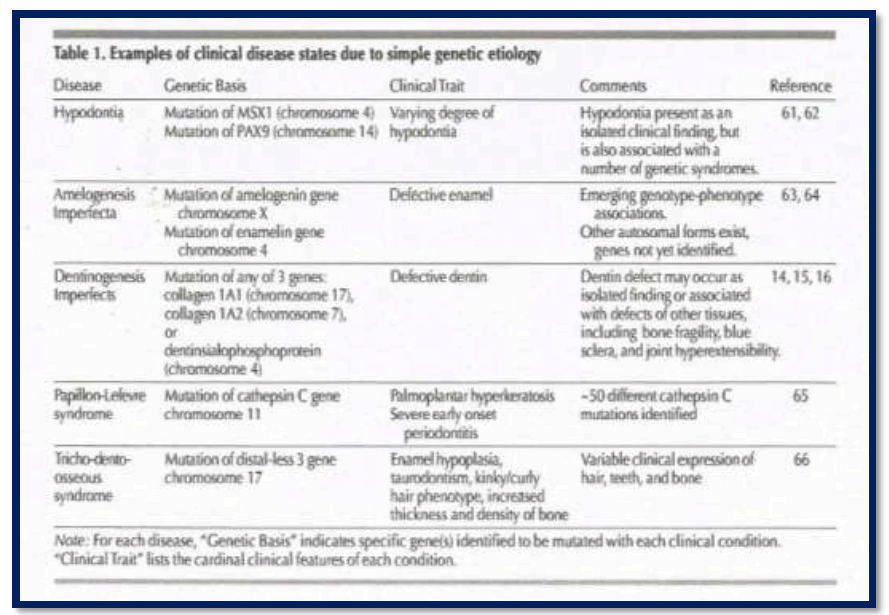
Table 4
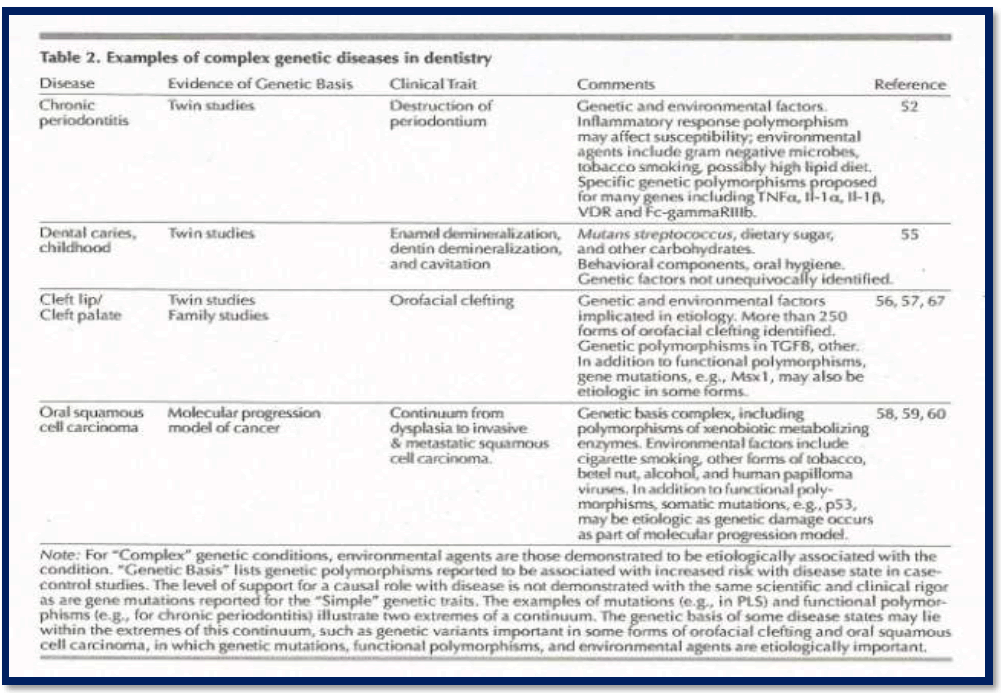
Dental hard tissues
Amelogenesis imperfecta
Amelogenesis imperfecta can be inherited as an autosomal dominant trait, or in autosomal recessive or Xlinked forms.
Autosomal dominant amelogenesis imperfecta
Autosomal dominant amelogenesis imperfecta (ADAI) has been mapped to the long arm of chromosome 4 in three Swedish families. The gene is located in the same region as that involved in dentinogenesis imperfecta. These genes are the albumin gene and the ameloblastin gene. It is not yet clear whether mutations in these genes are responsible for the ADAI in these families.
Dentinogenesis imperfecta was first identified as a disorder distinct from amelogenesis imperfecta by Finn. Shields et al. classified DI into type I (with osteogenesis imperfecta), type II (without osteogenesis imperfecta) and type III (the Brandywine type).
Dentinal dysplasia is another autosomal dominant form of inherited defects of dentine.
Dental caries
The genetic basis for dental caries was reviewed by Sofaer. Evidence from experimental caries in rats suggests that there is an approximately 50 per cent genetic contribution to the development of caries. Advances in the understanding of dental caries in humans have been limited.
Refer table 5
Table 5
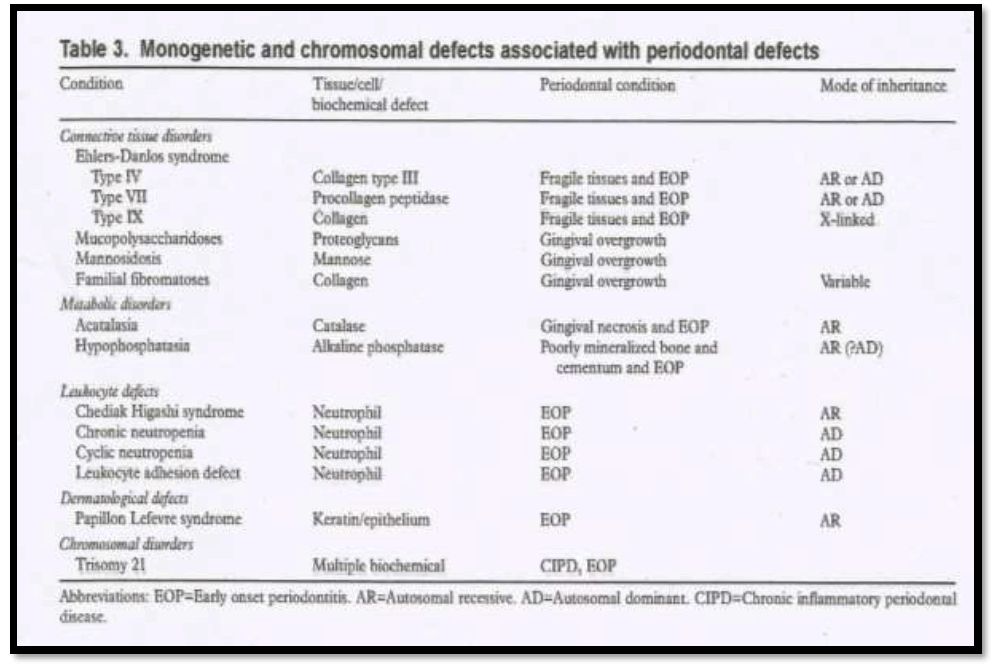
T.C. Hart, M.L. Marazita, J.T. Wright The Impact of Molecular Genetics on Oral Health Paradigms Crit Rev Oral Biol Med 2000;1 l(l):26-56
Genetic abnormalities affecting tissues of the oral cavity
A mutation in the MSX1 homeobox gene is associated with congenitally missing teeth, while X-linked hypohidrotic ectodermal dysplasia is caused by a novel transmembrane protein (Kere et al., 1996; Vastardis et al., 1996).
Hereditary conditions affecting the oral soft tissues
Gingival tissues
Alterations of the oral gingival tissues have been identified in a number of genetic conditions, including Sandhoff disease (MIM 268800), mannosidosis (MIM 248500), epidermolysis bullosa (MIM 226450) and hereditary gingival fibromatosis (MIM 135300).
Hereditary Gingival Fibromatosis (HGF) is the most common genetic form of gingival fibromatosis.
The condition is most often transmitted as an autosomal-dominant Mendelian trait, although autosomal-recessive transmission has been reported (Gorlin et al., 1990).
Genetic Conditions Affecting Cementum
▣ Defective cementum formation is seen in hypophosphatasia.
▣ Hypophosphatasia can be inherited as an autosomal dominant or recessive trait (MIM 241500, 241510, 146300) and is characterized by skeletal abnormalities as well as by defective cementum formation (Bruckner et al., 1962).
Cleidocranial dysplasia (CCD) (MIM 119600) is an autosomal-dominant condition characterized by hypoplasia/aplasia of clavicles, defective bone formation, short stature, supernumerary teeth, abnormal tooth eruption, and defective cementum formation.
The molecular basis of CCD is a mutation in the core-binding factor, runt domain, alpha subunit 1 (CBFA1) gene, a member of the runt family of transcription factors, located on chromosome 6p (Mundlos et al., 1997).
Genetic Conditions Affecting Dentin
Dentin is known to be affected in numerous syndromic and non-syndromic hereditary conditions. The most common Mendelian traits affecting dentin have historically been classified based on phenotype and histology (Shields et al., 1973).
Refer table 6
| DISEASE | TYPE OF INHERITANCE |
|---|---|
| 1. Osteogenesis Imperfecta | Autosomal Dominant |
| 2. Amelogenesis Imperfecta | Autosomal Dominant |
| 3. Dentinogenesis Imperfecta | Autosomal Dominant |
| 4. Agnathia, Thalassemia | Autosomal Recessive |
| 5. Sickel Cell Anaemia | Autosomal Dominant |
| 6. White Sponge Nevus | Autosomal Dominant |
| 7. Von Willebrands Disease | Autosomal Dominant |
| 8. Hemophilia | Sex linked recessive |
| 9. Cherubism, Achondroplasia, Cleidocranial dysplasia | Autosomal Dominant |
| 10. Cleft Lip, Cleft Palate, Apert Syndrome | Polygenic (Multifactorial Inheritance) |
| 11. Van der Woude Syndrome | 1 |
| 12. Peutz Jeughers Syndrome | Mutation of gene located on 19 |
| 13. Osteogenesis Imperfecta | 19 |
| 14. Marfan Syndrome | 15 |
| 15. Cherubism | 4 |
Table 6 - Some genetically transmitted diseases
Public Health Significance
Medical genetics and public health share a focus on populations in practice, disease, and policy making.While the effective integration of genetics and public health services is a key to effective disease intervention, it will be essential for clinicians, consumers and policymakers to understand the issues to ensure optimal results.
The role of genetics in dentistry will continue to evolve in the upcoming years Dentists and dental hygienists have a responsibility to integrate genetic information into their clinical practice as it becomes available. This is a challenge because most practicing oral health professionals have had little exposure to genetics in their training. The importance of genetics in dentistry has been recognized by the National Coalition for Health Professional Education in Genetics (NCHPEG), an “organization of organizations” committed to a national effort to promote health professional education and access to information about advances in human genetics. This coalition has developed an educational site “Genetics, Disease, and Dentistry” to help dental health professionals incorporate genetic concepts into practice.
Conclusion
An important goal of 21st century - medicine is to predict an individual’s medical future that is, to identify the set of risk factors for disease that influence a person’s health, with the goal of more effectively treating and preventing disease.Many environmental factors that influence health are known, but most of the genetic factors, much less interactions between the two, remain to be discovered. Genes determine most of the physical characteristics in a person such as colour, height, blood group.In each pair of chromosomes, one gene is inherited from mother and the other from the father. So, any mutation of gene cause wide range of conditions.
The future contribution of genetic discoveries to improving oral health will bring many opportunities as well as challenges. An informed dental professional can be an active contributor to the design of systems tools, and resources that integrate genetics into clinical care. This contribution to quality care starts with the recognition of the importance of genetics education, beginning now.
References
- Park K. Textbook of Preventive and Social Medicine 21st edition.Jabalpur,India:M/s Banarsidas Bhanot; pg.760-770.
- Thomas C. Hart, Robert E. Ferrell. Genetic Testing Considerations for Oral Medicine Journal of Dental Education 2002;66(10):1185-1202
- Grant C. Townsend, Michael J. Aldred, P. Mark Bartold. Genetic aspects of dental disorders.Australian Dental Journal 1998;43:4.
- T.C. Hart, M.L. Marazita, J.T. Wright . The Impact of Molecular Genetics on Oral Health Paradigms. Crit Rev Oral Biol Med 2000;1 l(l):26-56.
- Gregor Mendel. Available from : http://en.wikipedia.org/wiki/GregorMendel Accessed on : 12/4/14
- Genetic Research in India. Available from : www.chillibreeze.com/articles_various/Accessed on : 12/4/14
- Making Sense of Your Gene. American Board of Genetic Counselling. Available from : http://www.abgc.net/docs/gcbrochure%20final.pdf Accessed on : 12/4/14
- Genetic Counselling Centre for Genetic Education. Available from : http://www.genetics.edu.au Accessed on 16/4/14
- Genetic Counselling in India. Available from : http://www.Indiahospitalour.com/ivf/genetic counselling-India.html Accessed on 16/4/14
- enged.com.au/what-is-genetic-engineering Accessed on 21/4/14
- www.microrao.com Accessed on 21/4/14
- Kumar S, M Swapna. Dental Pulse. Third edition Hyderabad,India:Swapna Medical Publishers.pg.no.88-118.
Citation: Suvarna V Biradar, Genetic Disorders : Health and Oral Health – A Review, Asian Journal of Pharmaceutical Technology & Innovation, 6 (27); 36-52, 2018. www.asianpharmtech.com.

